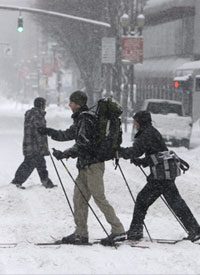
Leonard, who helped design the solar-powered outhouse, said the $140,000 price tag was nothing to worry about because “we’re patenting the design and we intend to actually market them.” The city could actually make a profit down the road, he said.
Mother Nature was less than cooperative, however, dumping record-breaking snowfalls on the Portland area in the three weeks following the green loo’s send-off.
According to news accounts, “Snow covered the restroom’s roof-mounted solar panels, cutting off the flow of power to the storage batteries, which were completely drained and damaged.” And without power, “The heat tape around the water lines stopped working, prompting the bureau to lock it up.” No reports yet on how much the repair costs will be, or when the loo will be open for business again.
More Green Woes for Portland
Seems the supposedly eco-friendly plans of Oregon’s greenies are backfiring all over the place. From solar-powered parking meters to energy-conserving building-code mandates, good intentions have gone awry. Peter Korn of the outlookonline.com reports: “Of all the reasons for hating Portland’s supposedly green parking ticket dispensers, consider this one: Each year, they produce more than 9 million pieces of little sticky-backed paper that clutter the floors of cars before they finally are disposed of — in the trash.”
“You probably never have tried to recycle a Portland parking meter receipt,” Korn continues, “which is a good thing, because they’re not recyclable. Once upon a time we put our quarters into parking machines and the waste was, well, nothing. Now we have solar-powered ticket dispensers that create an incredible amount of garbage.”
The ticket dispensers use about 6,500 rolls of thermal sensitive paper annually. “Being sustainable can be messy,” notes Korn. “And don’t forget about all the glass cleaner Portland residents use trying to remove from their windows the bits of sticky paper that didn’t cleanly come off at first yank.”
Far more serious, though, is Oregon’s state building code that is turning many buildings green — with mold. The newer airtight homes and commercial buildings don’t breathe, causing a major problem with mold and mildew, reports Korn.
— AP Images



